Commercial Salmon Fisheries
Berners River Coho Salmon Research
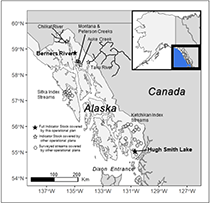
Figure 1. — Click for more Info

Figure 2. — Click for more Info

Figure 3. — Click for more Info
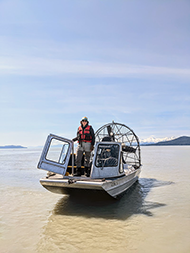
Figure 4. — Click for more Info
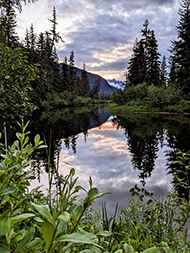
Figure 5. — Click for more Info

Figure 6. — Click for more Info
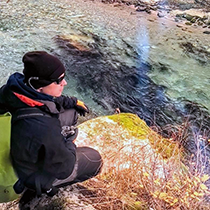
Figure 7. — Click for more Info
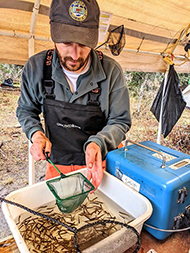
Figure 8. — Click for more Info
Introduction
The Berners River is located on the mainland of northern Southeast Alaska approximately 70 kilometers northwest of Juneau, Alaska (Figure 1). This clearwater river flows into the north end of Berners Bay, with its confluence adjacent to the glacial Lace and Antler Rivers. The Berners River valley transitions from a moderate gradient in the upper river (Figure 2) to low gradient in the lower river with many beaver ponds and side channels (Figure 3). These pristine aquatic conditions create ideal rearing and spawning habitat for salmon, especially coho salmon. For a river of its size, the Berners River hosts an impressive run of coho salmon, with typical escapements (number of salmon returning to rivers to spawn) exceeding several thousand adult coho salmon. The adult coho salmon escapement in the Berners River has been quite variable, ranging from 1,750 (1986) to over 27,000 (2002) adults. The current biological escapement goal range for Berners River is 3,600–8,100 adult coho salmon. Since 1982, coho salmon escapements have averaged approximately 8,500 fish.
The Berners River is one of three coho salmon indicator stocks in Southeast Alaska that are used to provide a representative view of how regionwide stocks are faring. Coho salmon sampling with similar protocols occurs in southern Southeast Alaska at Hugh Smith Lake, near Ketchikan, and at Auke Creek, near Juneau. ADF&G has been researching coho salmon in the Berners River since the early 1970s to better understand regional population dynamics and improve management decisions. Intermittent adult surveys and juvenile sampling coalesced into a systematic program in the mid-1980s, providing one of the longest time series of coho salmon abundances in Southeast Alaska. Smolt sampling crews work and stay in the lower Berners River for the entire season from early May until mid-June, accessing the camp location by crossing Berners Bay and boating upriver using airboats and jetboats (Figures 4 and 5). Due to the remote nature, adult sampling crews access the upper Berners River via helicopter for a 10-day survey in late October and hike all spawning ground locations.
Juvenile Coho Salmon Sampling
Juvenile salmon from Berners River are captured from early May until mid-June using a “spill trap” and oversize minnow (“gee”) traps. A spill trap funnels outmigrating juveniles from a large beaver pond complex (Shaul Pond) into a holding box where fish are safely held until picked up for transfer (Figure 6). Shaul Pond is exceptionally productive and in the most recent 10 years (2015–2024), approximately 77% of the coho salmon smolt captured in the Berners River project were from this location. Elsewhere minnow traps are operated along a side channel (“Brown Slough”) to collect juvenile coho salmon from the entire system. After capture, juvenile coho salmon smolt are brought back to camp for further sampling.
A subset of smolt is selected for scale sampling (to determine age) and length measurements. All healthy smolt are tagged with a coded wire tag (CWT) implanted in their snout. These tags are about the width of a hair and 1 mm long and have a unique code to identify the tagging location and year. Finally, all tagged smolt are externally marked by removing the adipose fin to quickly identify which fish contain a tag. Tagged smolt are released unharmed to continue their journey out to sea.
Adult Coho Salmon Surveys
Adult coho salmon surveys are conducted in late October during the typical peak spawning period. Aerial surveys from a helicopter are performed in the lower river (which typically contains <5% of the escapement) and foot surveys of all upper river areas are conducted during late October (Figure 7). These counts provide a very accurate enumeration of the total adults present, as previous radio telemetry and mark recapture studies have shown that most fish are contained within the survey area and the expansion between the survey count and mark recapture estimates was low. The upper Berners River provides an ideal location for spawning surveys as and most adults are distributed within a several mile section of the mainstem river. Spawning surveys usually occur prior to peak spawning after which time adult sampling operations begin with beach seines used to capture coho salmon. Fish are measured for length, scales are sampled for age analysis, and sex is determined using morphological characteristics. Fish missing their adipose fin are documented as this is an indicator that the fish could be tagged with a coded wire tag. These adipose fin clipped fish are scanned with a T wand to determine coded wire tag presence.
Harvest and Abundance of Berners River Coho
Adult coho salmon from the Berners River are harvested in many fisheries across northern Southeast Alaska, including commercial troll, commercial drift gillnet, and sport fisheries. Sampling of commercial fisheries is done by ADF&G Commercial Fisheries Port Sampling Program staff who inspect a representative harvest from each fishery and location. Similarly, sampling of sport fisheries is done by dockside ADF&G Catch Sampling staff. The CWTs recovered are read by staff at the ADF&G Mark, Tag, and Age Lab where fish can be assigned to a known release source. Using these data, the estimated harvest by fishery, location, and date can be quantified. Harvest information, along with the escapement information collected in the Berners River, is used to estimate total run size.
Known Age Study
A common problem with determining coho salmon age from their scales is that the exceptional growth exhibited by coho salmon, especially in their freshwater juvenile stage, can complicate reading the scale circuli. Beginning in the late 1990s at the Berners River and Hugh Smith Lake, ADF&G coho salmon researchers implemented a clever solution to this problem: tag fry soon after hatching (Figure 8) and then recover these fish as smolt and adults. Once tags are recovered and read, staff can know exactly how old the fish are and further refine scale pattern analysis for age determination. These “known age” scales are valuable to scale aging staff because they can be compared to other scales, greatly improving our confidence in aging. The ADF&G ‘known age” coho salmon scale collection is one of the only such datasets!
What We Learn
Combining the knowledge gained from harvest, coded wire tags released in juveniles, and coded wire tags recovered from adults allows for a powerful dataset to understand trends in regional coho salmon. Knowing the total run of adult salmon (harvest + escapement) helps create high quality spawner-recruit analyses and documents production trends over time. Harvest rates of Berners River coho salmon are assessed across different fisheries, providing a valuable tool for evaluating wild stock production. Additionally, estimating the abundance of outmigrating smolts allows us to calculate the annual marine survival rate as these fish mature from smolts to adults. This integrated approach enhances our understanding of population dynamics and informs effective management strategies.
Selected Publications
- Operational Plan for Research in the Berners River – Priest and Fish 2023 (PDF)
- Stock Status of Southeast Alaska Coho – Priest et al. 2021 (PDF)
- Berners River Coho Salmon Studies, 1972–2014 – Shaul et al. 2017 (PDF)
- Factors Affecting Coho Salmon Returns in Southeast Alaska – Shaul et al. 2019 (PDF)
